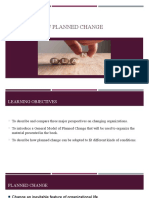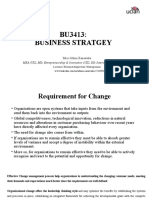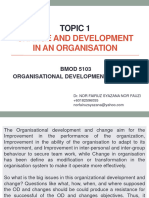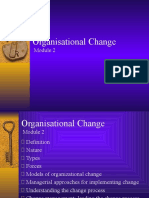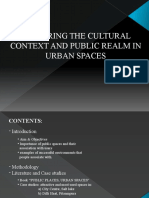0 ratings0% found this document useful (0 votes)
32 viewsThe Nature of Planned Change
The Nature of Planned Change
Uploaded by
Seema KhanThe document discusses three models of planned organizational change: Kurt Lewin's model of unfreezing, moving, and refreezing; the positive change model focusing on an organization's strengths; and a general model involving diagnosis, planning change, implementing change, and institutionalizing change. It also compares Lewin's model to other change and organizational development approaches.
Copyright:
© All Rights Reserved
Available Formats
Download as PPT, PDF, TXT or read online from Scribd
The Nature of Planned Change
The Nature of Planned Change
Uploaded by
Seema Khan0 ratings0% found this document useful (0 votes)
32 views17 pagesThe document discusses three models of planned organizational change: Kurt Lewin's model of unfreezing, moving, and refreezing; the positive change model focusing on an organization's strengths; and a general model involving diagnosis, planning change, implementing change, and institutionalizing change. It also compares Lewin's model to other change and organizational development approaches.
Original Title
Chap 2(OD) Final (2) (1)
Copyright
© © All Rights Reserved
Available Formats
PPT, PDF, TXT or read online from Scribd
Share this document
Did you find this document useful?
Is this content inappropriate?
The document discusses three models of planned organizational change: Kurt Lewin's model of unfreezing, moving, and refreezing; the positive change model focusing on an organization's strengths; and a general model involving diagnosis, planning change, implementing change, and institutionalizing change. It also compares Lewin's model to other change and organizational development approaches.
Copyright:
© All Rights Reserved
Available Formats
Download as PPT, PDF, TXT or read online from Scribd
Download as ppt, pdf, or txt
0 ratings0% found this document useful (0 votes)
32 views17 pagesThe Nature of Planned Change
The Nature of Planned Change
Uploaded by
Seema KhanThe document discusses three models of planned organizational change: Kurt Lewin's model of unfreezing, moving, and refreezing; the positive change model focusing on an organization's strengths; and a general model involving diagnosis, planning change, implementing change, and institutionalizing change. It also compares Lewin's model to other change and organizational development approaches.
Copyright:
© All Rights Reserved
Available Formats
Download as PPT, PDF, TXT or read online from Scribd
Download as ppt, pdf, or txt
You are on page 1of 17
The Nature of Planned Change
Chapter Format
Three models/theories of planned change
and Frame works
Process of planned change and challenges
Corporate application
Global , economic and technological
development and Planned change
The pace of global, economic, and
technological development makes change an
inevitable feature of organizational life.
Organizations can use planned change to
solve problems, to learn from experience,
to reframe shared perceptions, to adapt
to external environmental changes, to
improve performance, and to influence
future changes.
Planned change
Conceptions of planned change have tended
to focus on how change can be implemented
in organizations. Called “theories of
changing,” these frameworks describe the
“activities” that must take place to initiate
and carry out successful organizational
change.
Kurt Lewin Model
He conceived of “change as modification “of those forces
keeping a system’s behavior stable.
Two group, one appreciate change another resist change
A particular set of behaviors at any moment in time is the
result of two groups of forces:
“those striving to maintain the status quo and those
pushing for change –How to manage them.”
The level of performance of a work group might be
“stable” because “group norms maintaining that level are
equivalent to the supervisor’s pressures for change to
higher levels. “
WHAT TO DO? Corporate Application
Unfreezing.
Unfreezing. This step usually involves reducing those
forces maintaining the organization’s behavior at its
present level.
Unfreezing is sometimes accomplished
through a process of “psychological disconfirmation.”
By introducing information that shows “discrepancies
between behaviors” currently exhibited, members
can be motivated to engage in change activities to
reduce the gap in human behaviors as these are the
indicators of human performance
Moving
Moving. This step shifts the behavior of the
organization, department, or individual
to a new level.
It involves “intervening in the system to
develop new behaviors, values, and attitudes
through changes in organizational structures
and processes.
Refreezing.
Refreezing. Institutionalizing the change ,
make changes in every thing , prepare policy ,
re-write JDs .
This step stabilizes the organization at a new
state of equilibrium.
It is frequently accomplished through the use of
“supporting mechanisms that reinforce the new
organizational state, such as organizational
culture, rewards, and structures.
Adaptation in Lewin’s model
The planning model developed by Lippitt, Watson, and
Westley arranges Lewin’s model into seven steps:
scouting, entry, diagnosis (unfreezing), planning,
action (moving), stabilization and evaluation, and
termination (refreezing).
Similarly, Kotter’s eight stage process can be mapped
onto Lewin’s phases: establishing a sense of urgency,
creating the guiding coalition, developing a vision and
strategy, and communicating the change vision
(unfreezing); empowering broad-based action,
generating short-term wins (moving); and
consolidating gains and producing more change, and
anchoring new approaches in the culture (refreezing)
Positive Change Model
The positive model focuses on what the
“organization is doing right”. It helps members
understand their organization when it is working
at its best and builds off those capabilities to
achieve even better results.
This positive approach to change is consistent
with a growing movement in the social sciences
called “positive organizational scholarship,”
which focuses on positive dynamics in
organizations that give rise to extraordinary
outcomes.
Positive Change Model (2)
Research on expectation effects supports this
model of planned ; the research shows that
people tend to act in ways that make their
expectations occur.
Thus, positive expectations about the
organization can create an “anticipation ( How
they perceive change and what are their views to
resolve the issue) that energizes and directs
behavior toward making those beliefs happen.
(OD consultant and internal change team works
to start discussion with them)
Positive Change Model (3)
The positive model has been applied to
planned change primarily through a process
called appreciative inquiry (AI).24 As a
“reformist and rebellious” form of social
constructionism, AI explicitly infuses a
positive value orientation into analyzing and
changing organizations.
Comparative analysis of change and
OD models
All three approaches emphasize the application of
“behavioral science knowledge”, involve
organization members in the change process to
varying degrees, and recognize that any interaction
between a consultant and an organization
constitutes an intervention that may affect the
organization.
However, Lewin’s change model differs from the
other two in that it focuses on the general process
of planned change, rather than on specific OD
activities.
Entering and collecting
Entering an organization involves gathering
initial data to understand the problems facing
the organization or to determine the positive
areas for inquiry.
General model of planned Change(1)
Diagnosis:
In this stage of planned change, the client system is
carefully studied. Diagnosis can focus on
understanding organizational problems, including
their causes and consequences, or on collecting
stories about the organization’s positive attributes.
It includes choosing an appropriate model for
understanding the organization and gathering,
analyzing, and feeding back information to
managers and organization members about the
problems or opportunities that exist.
General model of planned Change(2)
Planning and Implementing Change
Organization members and practitioners jointly plan and
implement OD interventions. They design interventions to
achieve the organization’s vision or goals and make action
plans to implement them.
There are several criteria for designing interventions,
including the organization’s readiness for change, its
current change capability, its culture and power
distributions, and the change agent’s skills and abilities
In many cases, organizations do not get beyond this early
stage of planned change because one or more situations
arise: Disagreements about the need for change surface,
resource constraints are encountered, or other methods fo
change appear more feasible.
General model of planned Change(3)
Evaluating and Institutionalizing Change
The final stage in planned change involves
evaluating the effects of the intervention and
managing the institutionalization of successful
change programs so they persist.
Feedback to organization members about the
intervention’s results provides information about
whether the changes should be continued,
modified, or suspended. Institutionalizing
successful changes involves reinforcing them
through feedback, rewards, and training.
You might also like
- Organizational Development and Change ExamNotesDocument36 pagesOrganizational Development and Change ExamNotesAbbas T P90% (10)
- ELLN Focusing On The Science of Reading SORDocument14 pagesELLN Focusing On The Science of Reading SORRussell Marie AlisonNo ratings yet
- Barbie PDFDocument32 pagesBarbie PDFSeema Khan0% (1)
- The Self-Directed SearchDocument18 pagesThe Self-Directed Searchparodico_rNo ratings yet
- BSBLDR511 Develop and Use Emotional IntelligenceDocument23 pagesBSBLDR511 Develop and Use Emotional IntelligenceCuliikz Ade Ablugh0% (1)
- Tugas Resume Pengembangan Organisasi Chapter 2-7: Disusun OlehDocument34 pagesTugas Resume Pengembangan Organisasi Chapter 2-7: Disusun OlehReco NegsagisNo ratings yet
- Chapter - 4 Foundations of Organization DevelopmentDocument49 pagesChapter - 4 Foundations of Organization DevelopmentRahul Sood80% (15)
- Science Classification of Animals Lesson Plan 4 14Document8 pagesScience Classification of Animals Lesson Plan 4 14api-294619583No ratings yet
- THE NATURE OF PLANNED CHANGE-DoreenDocument27 pagesTHE NATURE OF PLANNED CHANGE-DoreenTusingwire DoreenNo ratings yet
- 2 Planned ChangeDocument6 pages2 Planned ChangeApril Joy Maña BuriNo ratings yet
- The Nature of Planned ChangeDocument12 pagesThe Nature of Planned ChangeSamina Nawaz100% (1)
- Organizational ChangeDocument12 pagesOrganizational ChangeRohit KaliaNo ratings yet
- Change Management - Theories of Planned ChangeDocument44 pagesChange Management - Theories of Planned ChangeRosenna99No ratings yet
- The Different Types of Organizational ChangeDocument6 pagesThe Different Types of Organizational ChangeabcNo ratings yet
- Chapter 15 SummaryDocument11 pagesChapter 15 SummaryGil Hernandez-ArranzNo ratings yet
- Organizational ChangeDocument9 pagesOrganizational Changeabc100% (1)
- The Nature of Planned Change: Chapter-2Document19 pagesThe Nature of Planned Change: Chapter-2Sunail HajatNo ratings yet
- HANDOUT 2 in Organizational DevelopmentDocument6 pagesHANDOUT 2 in Organizational DevelopmentLarjun DuhaylungsodNo ratings yet
- Od Fair 2024.1 21Document15 pagesOd Fair 2024.1 21batajuma66No ratings yet
- OC & D - Unit 1 - Theories of Planned ChangeDocument22 pagesOC & D - Unit 1 - Theories of Planned ChangeASHITA ANN STEPHEN MBA19-21No ratings yet
- OD and Change AssignmentDocument16 pagesOD and Change AssignmentUsmanNo ratings yet
- SID#: 1031425/1 Module: Organizational Behavior: Edition P 662)Document10 pagesSID#: 1031425/1 Module: Organizational Behavior: Edition P 662)Karen KaveriNo ratings yet
- Chapter Ocd2Document8 pagesChapter Ocd2Mr. Srikanth KNo ratings yet
- Organization Development and Change 10th 2015 BAB 1Document54 pagesOrganization Development and Change 10th 2015 BAB 1IndrabayuNo ratings yet
- MOC NotesDocument8 pagesMOC NotesVenkat RajuNo ratings yet
- Od Mod 2Document7 pagesOd Mod 2Harshita KapoorNo ratings yet
- Prelim AssessmentDocument2 pagesPrelim Assessmenteloisamarpiga.03No ratings yet
- Organization Change: Organizational Change Is The Process Through Which AnDocument25 pagesOrganization Change: Organizational Change Is The Process Through Which AnKrishna Kumar100% (1)
- Group 1 Chapter Two The Nature of Planned Change 20230929 165955 0000Document28 pagesGroup 1 Chapter Two The Nature of Planned Change 20230929 165955 0000saitamak317No ratings yet
- QTSTĐ Chương-2 AnhDocument23 pagesQTSTĐ Chương-2 AnhAN VU LIENNo ratings yet
- Module - 2: Organizational Change and ODDocument28 pagesModule - 2: Organizational Change and ODHai DeepuNo ratings yet
- Organisational Behaviour Module-3Document13 pagesOrganisational Behaviour Module-3Malvika PattnaikNo ratings yet
- What Is Organizational Development?Document3 pagesWhat Is Organizational Development?Yusra Jamil0% (1)
- Models of Change: Presented By: Usman Naseer Class: Bba 8ThDocument7 pagesModels of Change: Presented By: Usman Naseer Class: Bba 8ThUsmanNo ratings yet
- History of Org Models.Document8 pagesHistory of Org Models.batajuma66No ratings yet
- Kurt Lewin's 3-Stage Model in Org ChangeDocument5 pagesKurt Lewin's 3-Stage Model in Org ChangeDinah Valencia0% (1)
- Change ManagementDocument19 pagesChange ManagementPranjalNo ratings yet
- You Can Download 8 Ultimate HR Tools For HR Managers HEREDocument2 pagesYou Can Download 8 Ultimate HR Tools For HR Managers HEREസഞ്ചാരി ആർNo ratings yet
- MG312 AssignmentDocument4 pagesMG312 AssignmentTryler ChikovaNo ratings yet
- Implemetation ChangeDocument30 pagesImplemetation ChangeSingh DhaliwalNo ratings yet
- Everest OB Unit XI Org Change & DevDocument38 pagesEverest OB Unit XI Org Change & Devdolevov652No ratings yet
- PO - Session 15 - Chapter 17 - Group 6Document8 pagesPO - Session 15 - Chapter 17 - Group 6AliceNo ratings yet
- Managing ChangeDocument63 pagesManaging ChangeRameela AkramNo ratings yet
- The Nature of Planned ChangeDocument5 pagesThe Nature of Planned Changeفیضان محبوبNo ratings yet
- Week 12Document43 pagesWeek 12Arishragawendhra NagarajanNo ratings yet
- 3change Models andDocument16 pages3change Models andnoureldinfatmaNo ratings yet
- Mod 6Document13 pagesMod 6Nikita SangalNo ratings yet
- Tutorial 2Document6 pagesTutorial 2Muhammad FarezNo ratings yet
- Topic 1 OdcDocument12 pagesTopic 1 OdcAraysya SSNo ratings yet
- Module 5 OBDocument15 pagesModule 5 OBanandhuNo ratings yet
- Section: Organization Development Unit - I - ADocument31 pagesSection: Organization Development Unit - I - AAilyn NaragaNo ratings yet
- HRM Module 6 2021Document23 pagesHRM Module 6 2021ನಂದನ್ ಎಂ ಗೌಡNo ratings yet
- HRM-5104 NotesDocument31 pagesHRM-5104 NotesmayakhatunwasifNo ratings yet
- Foundations of ODDocument54 pagesFoundations of ODmunibhaskar100% (1)
- Models of Planned Change..Document27 pagesModels of Planned Change..Vishal Singh Jaswal100% (1)
- Organization Change & Development: Nature of Planned ChangeDocument29 pagesOrganization Change & Development: Nature of Planned ChangeKh Aqeel FarooqiNo ratings yet
- Change 2Document52 pagesChange 2Alwyn PintoNo ratings yet
- Unfree Change Refreeze Strategic Change Agents DefusingDocument12 pagesUnfree Change Refreeze Strategic Change Agents DefusingMichael ZarandonaNo ratings yet
- Organizational ChangeDocument19 pagesOrganizational ChangeRIDDHI TAMBI100% (3)
- Lesson 9 - HboDocument8 pagesLesson 9 - HboPrdsdef66 LimNo ratings yet
- Organizational Change: Organizational Change - A Process in Which A Large Company orDocument15 pagesOrganizational Change: Organizational Change - A Process in Which A Large Company orerielle mejico100% (2)
- Mohanlal Sukhadia University: Department: Faculty of Management StudiesDocument25 pagesMohanlal Sukhadia University: Department: Faculty of Management StudiesHitesh ChoudharyNo ratings yet
- Built to Change (Review and Analysis of Lawler and Worley's Book)From EverandBuilt to Change (Review and Analysis of Lawler and Worley's Book)No ratings yet
- Seema 22181 Pep Assignment 8Document21 pagesSeema 22181 Pep Assignment 8Seema KhanNo ratings yet
- Vision MissionDocument24 pagesVision MissionSeema KhanNo ratings yet
- Rs Article 7Document17 pagesRs Article 7Seema KhanNo ratings yet
- Strategy ClassificationDocument12 pagesStrategy ClassificationSeema KhanNo ratings yet
- Diagnosing Organizational System CH 6Document12 pagesDiagnosing Organizational System CH 6Seema KhanNo ratings yet
- Assignment # 2: Faculty: Sir Zafar MehdiDocument2 pagesAssignment # 2: Faculty: Sir Zafar MehdiSeema KhanNo ratings yet
- Class Summary 15th OctDocument5 pagesClass Summary 15th OctSeema KhanNo ratings yet
- Case Study Exide BatteryDocument3 pagesCase Study Exide BatterySeema KhanNo ratings yet
- Reading Assignment 5Document5 pagesReading Assignment 5Seema KhanNo ratings yet
- Industrial Development in Pakistan: Dr. Asghar AliDocument40 pagesIndustrial Development in Pakistan: Dr. Asghar AliSeema KhanNo ratings yet
- Chap 1 Part 2 ODDocument12 pagesChap 1 Part 2 ODSeema KhanNo ratings yet
- Interviewing Candidates Lec 8 9.26.2018Document13 pagesInterviewing Candidates Lec 8 9.26.2018Seema KhanNo ratings yet
- Kindness and Respect For Other People: Kind, Affectionate and Respectful ToDocument1 pageKindness and Respect For Other People: Kind, Affectionate and Respectful ToSeema KhanNo ratings yet
- CB QuizDocument3 pagesCB QuizSeema KhanNo ratings yet
- Final Term Project B: Faculty: Sir Dr. Omar JavedDocument22 pagesFinal Term Project B: Faculty: Sir Dr. Omar JavedSeema KhanNo ratings yet
- Customer Adoption PyramidDocument3 pagesCustomer Adoption PyramidSeema KhanNo ratings yet
- SPB Monetary Policy AnalysisDocument5 pagesSPB Monetary Policy AnalysisSeema KhanNo ratings yet
- It'S Barbie'S World, You'Re Just Living in It: The Right FitDocument32 pagesIt'S Barbie'S World, You'Re Just Living in It: The Right FitSeema KhanNo ratings yet
- Production and Operation AssignmentDocument12 pagesProduction and Operation AssignmentSeema KhanNo ratings yet
- Brand Assignment 3 (Brand Key of Metro)Document18 pagesBrand Assignment 3 (Brand Key of Metro)Seema KhanNo ratings yet
- Summary of ArticleDocument3 pagesSummary of ArticleSeema KhanNo ratings yet
- Figure 1 Showing Discrete VariableDocument3 pagesFigure 1 Showing Discrete VariableSeema KhanNo ratings yet
- Observation/Interview/View: Field Study 1Document10 pagesObservation/Interview/View: Field Study 1Benjo Tanguan BaquirinNo ratings yet
- No. 17Document2 pagesNo. 17Sarah mae EmbalsadoNo ratings yet
- Mind Rubrics RepertoryDocument283 pagesMind Rubrics RepertoryAshfaq Ahmad100% (2)
- SPOLSKY - Towards A Theory of Language PolicyDocument10 pagesSPOLSKY - Towards A Theory of Language PolicyvitorjochimsNo ratings yet
- Wa0004.Document67 pagesWa0004.asimff1122No ratings yet
- Writing at Masters LevelDocument20 pagesWriting at Masters Levelnirajthurai100% (2)
- Lesson PlanDocument5 pagesLesson PlanLaarni Kiamco Ortiz EpanNo ratings yet
- Nonfiction Reading Test Chess: Directions: Read The Following Passage and Answer The Questions That Follow. Refer ToDocument4 pagesNonfiction Reading Test Chess: Directions: Read The Following Passage and Answer The Questions That Follow. Refer ToRikza StarrNo ratings yet
- Longman Linguistics: AppliedDocument6 pagesLongman Linguistics: AppliedAleNo ratings yet
- DLL Mathematics 4 q4 w7Document3 pagesDLL Mathematics 4 q4 w7Jonalis MandrialNo ratings yet
- Factors That Influence The Study of CRS inDocument10 pagesFactors That Influence The Study of CRS ingold2k4all9282No ratings yet
- Advantages of Audio Media in Teaching and Learning, and How It Can Be UsedDocument6 pagesAdvantages of Audio Media in Teaching and Learning, and How It Can Be UsedKhairunnisa SharomNo ratings yet
- Assessment LiteracyDocument5 pagesAssessment Literacyapi-347236148100% (1)
- MT Yr 6 DLPDocument1 pageMT Yr 6 DLPAnonymous jHgxmwZNo ratings yet
- Case StudyDocument21 pagesCase StudyHelen Harlyn100% (2)
- Contextual Factors 2014Document3 pagesContextual Factors 2014api-253021879No ratings yet
- Starter Unit Test 1: Grammar VocabularyDocument2 pagesStarter Unit Test 1: Grammar VocabularySekine IsmayilovaNo ratings yet
- The Big Five Personality Test (BFPT)Document6 pagesThe Big Five Personality Test (BFPT)Maliha NazarNo ratings yet
- Exploring The Cultural Context and Public Realm in Urban SpacesDocument36 pagesExploring The Cultural Context and Public Realm in Urban SpacesAdrish NaskarNo ratings yet
- I. Objectives A. Content StandardsDocument4 pagesI. Objectives A. Content Standardszoe mercadoNo ratings yet
- معلم المرحلة الابتدائية وتحديات تعامله مع التلاميذ ذوي صعوبات التعلمDocument16 pagesمعلم المرحلة الابتدائية وتحديات تعامله مع التلاميذ ذوي صعوبات التعلمFatima ZahraaNo ratings yet
- Portfolio Headers (RPMS PPST)Document19 pagesPortfolio Headers (RPMS PPST)leana marie ballesterosNo ratings yet
- Module 5 - Training and Development UpdatedDocument55 pagesModule 5 - Training and Development UpdatedManisha KumariNo ratings yet
- Sample Interview QuestionsDocument2 pagesSample Interview QuestionsOneTonyOne100% (2)
- Internet Banking in Jordan: An Arabic Instrument Validation ProcessDocument12 pagesInternet Banking in Jordan: An Arabic Instrument Validation ProcessSai BabaNo ratings yet
- Validating Computational Models: Kathleen M. CarleyDocument24 pagesValidating Computational Models: Kathleen M. CarleyhGNo ratings yet
















